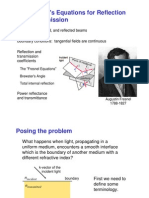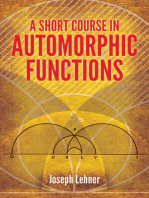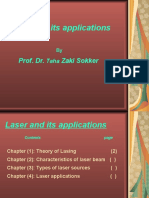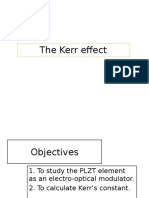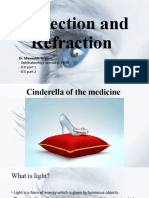Fresnel's Equations For Reflection and Refraction: Incident, Transmitted, and Reflected Beams
Uploaded by
Andy PratamaFresnel's Equations For Reflection and Refraction: Incident, Transmitted, and Reflected Beams
Uploaded by
Andy Pratama13.
Fresnel's Equations for Reflection
and Refraction
Incident, transmitted, and reflected beams
Boundary conditions: tangential fields are continuous
Reflection and
transmission
coefficients
The "Fresnel Equations"
Brewster's Angle
Total internal reflection
Power reflectance
and transmittance
Augustin Fresnel
1788-1827
Posing the problem
What happens when light, propagating in a
uniform medium, encounters a smooth interface
which is the boundary of another medium with a
different refractive index?
k-vector of the
incident light
boundary
n
incident
n
transmitted
This is really two problems, not just one.
Definitions: Planes of Incidence, the
interface and S and P polarizations
S polarization is the perpendicular polarization, and it sticks up
out of the plane of incidence
Plane of the interface (y=0, the xz
plane) (perpendicular to screen)
P polarization is the parallel polarization, and it lies parallel
to the plane of incidence.
Plane of incidence (z=0)
is the plane that
contains the incident
and reflected k-vectors.
x
y
z
I
R
T
n
i
n
t
i
k
r
k
t
k
i
r
t
E
i
B
i
E
r
B
r
E
t
B
t
Interface
Fresnel Equations
We would like to compute the fraction of a light wave reflected and
transmitted by a flat interface between two media with different refrac-
tive indices. Fresnel was the first to do this calculation (early 1800s).
x
y
z
Beam geometry for
light with its electric
field sticking up out of
the plane of incidence
(i.e., out of the page)
We treat the case of S polarization first:
the xz plane (y = 0)
n
i
n
t
i
k
r
k
t
k
t
E
i
B
i
E
r
B
r
E
t
B
t
Interface
Boundary Condition for the Electric
Field at an Interface: s polarization
x
y
z
In other words,
The Tangential Electric Field is Continuous
So: E
i
(y= 0) + E
r
(y= 0) = E
t
(y= 0)
The total E-field in
the plane of the
interface is
continuous.
Here, all E-fields are
in the z-direction,
which is in the plane
of the interface.
(Were not explicitly writing
the x, z, and t dependence,
but it is still there.)
Boundary Condition for the Magnetic
Field at an Interface: s polarization
n
i
n
t
i
k
r
k
t
k
t
E
i
B
i
E
r
B
r
E
t
B
t
Interface
x
y
z
i
*It's really the tangential B/, but we're using
i
=
t
=
0
B
i
(y= 0) cos
i
+ B
r
(y= 0) cos
r
= B
t
(y= 0) cos
t
The Tangential Magnetic Field* is Continuous
In other words,
The total B-field in the
plane of the interface is
continuous.
Here, all B-fields are in
the xy-plane, so we take
the x-components:
Reflection and Transmission for
Perpendicularly Polarized Light
Ignoring the rapidly varying parts of the light wave and keeping
only the complex amplitudes:
0 0 0
0 0 0
cos( ) cos( ) cos( )
+ =
+ =
i r t
i i r r t t
E E E
B B B
0 0 0 0
0 0 0 0
:
( )cos( ) ( )cos( )
Substituting for using + =
= +
t i r t
i r i i t r i t
E E E E
n E E n E E
0 0 0
( )cos( ) cos( ) =
i r i i t t t
n E E nE
0 0
/( / ) / . But and = = =
i r
B E c n nE c
Substituting into the second equation:
Reflection & Transmission Coefficients
for Perpendicularly Polarized Light
[ ] [ ]
0 0 0 0
0 0
( )cos( ) ( )cos( ) :
cos( ) cos( ) cos( ) cos( )
i r i i t r i t
r i i t t i i i t t
n E E n E E
E n n E n n
= +
+ =
Rearranging yields
[ ]
0 0
/ 2 cos( )/ cos( ) cos( )
t i i i i i t t
t E E n n n
= = +
0 0
/ , is
t i
E E Analogously, the transmission coefficient,
[ ] [ ]
0 0
/ cos( ) cos( ) / cos( ) cos( )
r i i i t t i i t t
r E E n n n n
= = +
0 0
/
r i
E E Solving for yields the reflection coefficient:
These equations are called the Fresnel Equations for
perpendicularly polarized (s-polarized) light.
n
i
n
t
i
k
r
k
t
k
i
r
t
E
i
B
i
E
r
B
r
E
t
B
t
Interface
Fresnel EquationsParallel electric field
x
y
z
Beam geometry
for light with its
electric field
parallel to the
plane of incidence
(i.e., in the page)
Note that the reflected magnetic field must point into the screen to
achieve for the reflected wave. The x with a circle
around it means into the screen.
E B k
Note that Hecht
uses a different
notation for the
reflected field,
which is confusing!
Ours is better!
This leads to a
difference in the
signs of some
equations...
Now, the case of P polarization:
Reflection & Transmission Coefficients
for Parallel Polarized Light
These equations are called the Fresnel Equations for
parallel polarized (p-polarized) light.
[ ] [ ]
|| 0 0
/ cos( ) cos( ) / cos( ) cos( )
r i i t t i i t t i
r E E n n n n = = +
[ ]
|| 0 0
/ 2 cos( )/ cos( ) cos( )
t i i i i t t i
t E E n n n = = +
Solving for E
0r
/ E
0i
yields the reflection coefficient, r
||
:
Analogously, the transmission coefficient, t
||
= E
0t
/ E
0i
, is
For parallel polarized light, B
0i
B
0r
= B
0t
and E
0i
cos(
i
) + E
0r
cos(
r
) =E
0t
cos(
t
)
To summarize
||
cos( ) cos( )
cos( ) cos( )
=
+
i t t i
i t t i
n n
r
n n
||
2 cos( )
cos( ) cos( )
=
+
i i
i t t i
n
t
n n
2 cos( )
cos( ) cos( )
=
+
i i
i i t t
n
t
n n
cos( ) cos( )
cos( ) cos( )
=
+
i i t t
i i t t
n n
r
n n
s-polarized light: p-polarized light:
And, for both polarizations:
sin( ) sin( ) =
i i t t
n n
p
la
n
e
o
f
in
c
id
e
n
c
e
incident
wave
transmitted wave
interface
p
la
n
e
o
f
in
c
id
e
n
c
e
incident
wave
transmitted wave
interface
E-field vectors are red.
k vectors are black.
Reflection Coefficients for an
Air-to-Glass Interface
Incidence angle,
i
R
e
f
l
e
c
t
i
o
n
c
o
e
f
f
i
c
i
e
n
t
,
r
1.0
.5
0
-.5
-1.0
r
||
r
0 30 60 90
The two polarizations are
indistinguishable at = 0
Total reflection at = 90
for both polarizations.
n
air
1 < n
glass
1.5
Brewsters angle
r
||
=0!
Zero reflection for parallel
polarization at 56.3
Brewster's angle
The value of this angle
depends on the value of
the ratio n
i
/n
t
:
Brewster
= tan
-1
(n
t
/n
i
)
Sir David Brewster
1781 - 1868
Incidence angle,
i
R
e
f
l
e
c
t
i
o
n
c
o
e
f
f
i
c
i
e
n
t
,
r
1.0
.5
0
-.5
-1.0
r
||
r
0 30 60 90
Brewsters
angle
Total internal
reflection
Critical
angle
Critical
angle
Total internal reflection
above the " critical angle"
crit
sin
-1
(n
t
/n
i
)
41.8 for glass-to-air
n
glass
> n
air
(The sine in Snell's Law
can't be greater than one!)
Reflection Coefficients for a
Glass-to-Air Interface
Reflectance (R)
R Reflected Power / Incident Power
r r
i i
I A
I A
=
Because the angle of incidence = the angle of reflection,
the beam area doesnt change on reflection.
Also, nis the same for both incident and reflected beams.
A = Area
2
0 0
0
2
c
I n E
i
w
i
n
i
n
t
r
w
i
2
R r =
So: since
2
0 2
2
0
=
r
i
E
r
E
Transmittance (T)
t t
i i
I A
I A
=
A = Area
2
0 0
0
2
c
I n E
=
cos( )
cos( )
t t t
i i i
A w
A w
= =
i
w
i
w
t
n
i
n
t
If the beam
has width w
i
:
2
0 0
2
0
0 2
2
2
0 0
0
0
2
2
t t
t t t
t t t t t
i i i i i
i i i
i i
c
n E
n E w
I A w nw
T t
c
I A w nw
n E w
n E
| |
|
(
' .
= = = =
(
| |
|
' .
The beam expands (or contracts) in one dimension on refraction.
since
2
0 2
2
0
t
i
E
t
E
=
( ) ( )
( ) ( )
2
cos
cos
t t
i i
n
T t
n
T Transmitted Power / Incident Power
Reflectance and Transmittance for an
Air-to-Glass Interface
Note that it is NOT true that: r + t = 1.
But, it is ALWAYS true that: R + T = 1
Perpendicular polarization
Incidence angle,
i
1.0
.5
0
0 30 60 90
R
T
Parallel polarization
Incidence angle,
i
1.0
.5
0
0 30 60 90
R
T
Brewsters
angle
Perpendicular polarization
Incidence angle,
i
1.0
.5
0
0 30 60 90
R
T
Reflectance and Transmittance for a
Glass-to-Air Interface
Parallel polarization
Incidence angle,
i
1.0
.5
0
0 30 60 90
R
T
Note that the critical angle is the same for both polarizations.
And still, R + T = 1
Reflection at normal incidence,
i
= 0
2
t i
t i
n n
R
n n
=
+
( )
2
4
t i
t i
nn
T
n n
=
+
When
i
=0, the Fresnel
equations reduce to:
For an air-glass interface (n
i
=1and n
t
=1.5),
R= 4% and T = 96%
The values are the same, whichever
direction the light travels, from air to
glass or from glass to air.
This 4% value has big implications
for photography.
lens flare
Windows look like mirrors at night (when youre in the brightly lit room)
One-way mirrors (used by police to interrogate bad guys) are just
partial reflectors (actually, with a very thin aluminum coating).
Disneyland puts ghouls next to you in the haunted house using partial
reflectors (also aluminum-coated).
Optical fibers use total internal reflection.
Where youve seen Fresnels Equations in action
R=100%
R=90%
Laser medium
0% reflection!
0% reflection!
Some lasers use Brewsters angle components to avoid reflective losses:
You might also like
- Fresnel's Equations For Reflection and Refraction: Incident, Transmitted, and Reflected BeamsNo ratings yetFresnel's Equations For Reflection and Refraction: Incident, Transmitted, and Reflected Beams19 pages
- Fresnel's Equations For Reflection and Refraction: Incident, Transmitted, and Reflected BeamsNo ratings yetFresnel's Equations For Reflection and Refraction: Incident, Transmitted, and Reflected Beams19 pages
- Fresnel's Equations For Reflection and Transmission: Incident, Transmitted, and Reflected BeamsNo ratings yetFresnel's Equations For Reflection and Transmission: Incident, Transmitted, and Reflected Beams22 pages
- Fresnel's Equations For Reflection and RefractionNo ratings yetFresnel's Equations For Reflection and Refraction46 pages
- Fresnel's Equations For Reflection and RefractionNo ratings yetFresnel's Equations For Reflection and Refraction37 pages
- Fresnel Relations: Phys 531 13 September 2005No ratings yetFresnel Relations: Phys 531 13 September 200516 pages
- Electromagnetic (E-M) Theory of Waves at A Dielectric InterfaceNo ratings yetElectromagnetic (E-M) Theory of Waves at A Dielectric Interface24 pages
- Brewsters Angle and Polarization Manual1No ratings yetBrewsters Angle and Polarization Manual18 pages
- The Fresnel Equations and Brewster's Law: Equipment100% (1)The Fresnel Equations and Brewster's Law: Equipment6 pages
- Design and Correction of Optical Systems: Lecture 1: Basics 2017-04-07 Herbert GrossNo ratings yetDesign and Correction of Optical Systems: Lecture 1: Basics 2017-04-07 Herbert Gross46 pages
- Electromagnetic Waves: Electromagnetic Wave at The Interface Between Two Dielectric MediaNo ratings yetElectromagnetic Waves: Electromagnetic Wave at The Interface Between Two Dielectric Media15 pages
- Dielectric Interface & Fresnel'S EquationsNo ratings yetDielectric Interface & Fresnel'S Equations34 pages
- Electromagnetic Wave Propagation Lecture 12: Oblique Incidence INo ratings yetElectromagnetic Wave Propagation Lecture 12: Oblique Incidence I46 pages
- EM Waves in Material Media: 1 Wave PropagationNo ratings yetEM Waves in Material Media: 1 Wave Propagation8 pages
- Electromagnetic Theory - Sample MaterialNo ratings yetElectromagnetic Theory - Sample Material8 pages
- The Reflection and Refraction of Electromagnetic WavesNo ratings yetThe Reflection and Refraction of Electromagnetic Waves47 pages
- Refraction and Polarization SupplementalNo ratings yetRefraction and Polarization Supplemental3 pages
- Mohammed_2019_IOP_Conf._Ser.__Mater._Sci._Eng._518_032026No ratings yetMohammed_2019_IOP_Conf._Ser.__Mater._Sci._Eng._518_03202610 pages
- Problem I Reflection and Refraction of Light A. An Interesting PrismNo ratings yetProblem I Reflection and Refraction of Light A. An Interesting Prism9 pages
- Feynman Lectures Simplified 2C: Electromagnetism: in Relativity & in Dense MatterFrom EverandFeynman Lectures Simplified 2C: Electromagnetism: in Relativity & in Dense MatterNo ratings yet
- Addis Ababa University College of Health Sciences School of Pharmacy Department of Pharmaceutical Chemistry and PharmacognosyNo ratings yetAddis Ababa University College of Health Sciences School of Pharmacy Department of Pharmaceutical Chemistry and Pharmacognosy35 pages
- Encyclopedia of Spectroscopy and Spectrometry (Second Edition)No ratings yetEncyclopedia of Spectroscopy and Spectrometry (Second Edition)6 pages
- Part 1: Choose The Best Answer From The Options Underneath EachNo ratings yetPart 1: Choose The Best Answer From The Options Underneath Each11 pages
- EPRI TR 1004019 Guide For Develping and Managing An IRT Program PDFNo ratings yetEPRI TR 1004019 Guide For Develping and Managing An IRT Program PDF108 pages
- A Dual-Polarized Antenna With Low Cross Polarization, HighNo ratings yetA Dual-Polarized Antenna With Low Cross Polarization, High15 pages
- Transmission Media: Solutions To Odd-Numbered Review Questions and ExercisesNo ratings yetTransmission Media: Solutions To Odd-Numbered Review Questions and Exercises4 pages
- REVISI - KLP 1 - Seminar Awal (Black Body Radiation)No ratings yetREVISI - KLP 1 - Seminar Awal (Black Body Radiation)15 pages
- Laboratory Activity 2.1 - The Visible Light SpectrumNo ratings yetLaboratory Activity 2.1 - The Visible Light Spectrum3 pages
- Fresnel's Equations For Reflection and Refraction: Incident, Transmitted, and Reflected BeamsFresnel's Equations For Reflection and Refraction: Incident, Transmitted, and Reflected Beams
- Fresnel's Equations For Reflection and Refraction: Incident, Transmitted, and Reflected BeamsFresnel's Equations For Reflection and Refraction: Incident, Transmitted, and Reflected Beams
- Fresnel's Equations For Reflection and Transmission: Incident, Transmitted, and Reflected BeamsFresnel's Equations For Reflection and Transmission: Incident, Transmitted, and Reflected Beams
- Electromagnetic (E-M) Theory of Waves at A Dielectric InterfaceElectromagnetic (E-M) Theory of Waves at A Dielectric Interface
- The Fresnel Equations and Brewster's Law: EquipmentThe Fresnel Equations and Brewster's Law: Equipment
- Design and Correction of Optical Systems: Lecture 1: Basics 2017-04-07 Herbert GrossDesign and Correction of Optical Systems: Lecture 1: Basics 2017-04-07 Herbert Gross
- Electromagnetic Waves: Electromagnetic Wave at The Interface Between Two Dielectric MediaElectromagnetic Waves: Electromagnetic Wave at The Interface Between Two Dielectric Media
- Electromagnetic Wave Propagation Lecture 12: Oblique Incidence IElectromagnetic Wave Propagation Lecture 12: Oblique Incidence I
- The Reflection and Refraction of Electromagnetic WavesThe Reflection and Refraction of Electromagnetic Waves
- Mohammed_2019_IOP_Conf._Ser.__Mater._Sci._Eng._518_032026Mohammed_2019_IOP_Conf._Ser.__Mater._Sci._Eng._518_032026
- Problem I Reflection and Refraction of Light A. An Interesting PrismProblem I Reflection and Refraction of Light A. An Interesting Prism
- Feynman Lectures Simplified 2C: Electromagnetism: in Relativity & in Dense MatterFrom EverandFeynman Lectures Simplified 2C: Electromagnetism: in Relativity & in Dense Matter
- Shortcuts to College Calculus Refreshment KitFrom EverandShortcuts to College Calculus Refreshment Kit
- Addis Ababa University College of Health Sciences School of Pharmacy Department of Pharmaceutical Chemistry and PharmacognosyAddis Ababa University College of Health Sciences School of Pharmacy Department of Pharmaceutical Chemistry and Pharmacognosy
- Encyclopedia of Spectroscopy and Spectrometry (Second Edition)Encyclopedia of Spectroscopy and Spectrometry (Second Edition)
- Part 1: Choose The Best Answer From The Options Underneath EachPart 1: Choose The Best Answer From The Options Underneath Each
- EPRI TR 1004019 Guide For Develping and Managing An IRT Program PDFEPRI TR 1004019 Guide For Develping and Managing An IRT Program PDF
- A Dual-Polarized Antenna With Low Cross Polarization, HighA Dual-Polarized Antenna With Low Cross Polarization, High
- Transmission Media: Solutions To Odd-Numbered Review Questions and ExercisesTransmission Media: Solutions To Odd-Numbered Review Questions and Exercises
- REVISI - KLP 1 - Seminar Awal (Black Body Radiation)REVISI - KLP 1 - Seminar Awal (Black Body Radiation)
- Laboratory Activity 2.1 - The Visible Light SpectrumLaboratory Activity 2.1 - The Visible Light Spectrum


